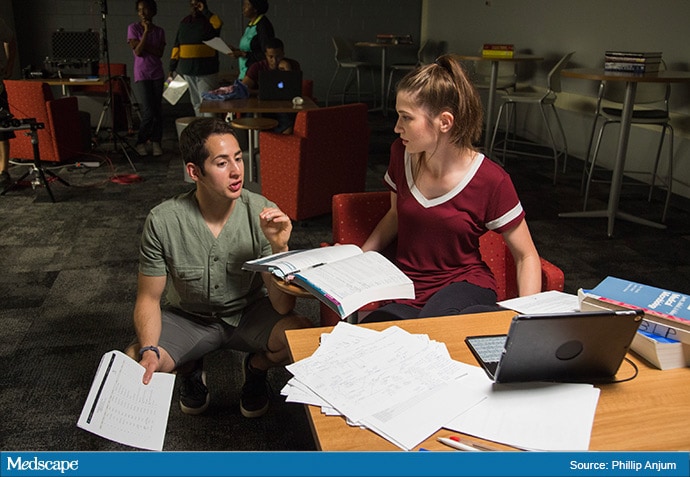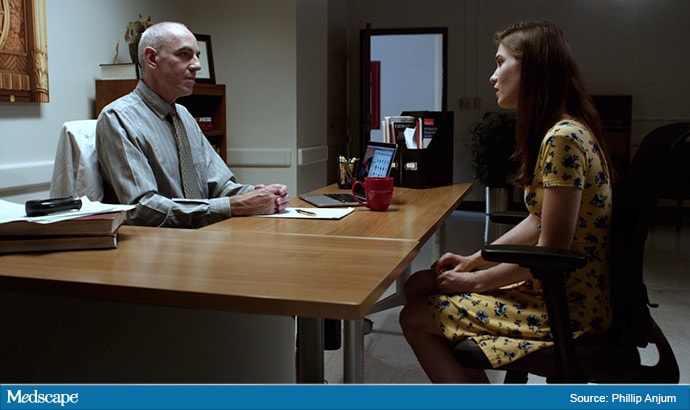This Q&A has been edited for clarity.
What if the figurative terror faced by medical students was turned into literal, tangible horror?
Phillip Anjum, a third-year medical student at The Ohio State University College of Medicine in Columbus, Ohio, wanted to find a new way to demonstrate the stress, anxiety, and isolation experienced by medical trainees. Drawing upon his background in film, he made History of Present Illness, a horror short that tackles med student burnout in a more visceral way.
We spoke with Anjum about what he hopes school administrators and others in medicine take from his project, as well as his experience of balancing filmmaking with becoming a doctor.
What was your motivation in turning your medical school experience into a literal horror film?
The first 2 years of medical school are rough. I don't think anyone has a smooth ride. I wanted to represent that in a way that was unique and also not in a way that is constantly sugarcoated by medical schools. I think all medical schools suggest that, when you come there, you are taken care of. You have your classmates and your advisors, and everyone is supporting you and you get through it. But when you actually get there, you realize that medical training in general is a very isolating experience.
I think there's no way that you can get around that, and I think the sooner that you realize that and develop ways to deal with the stress and anxiety, the sooner you can be successful in your training.
We all feel lonely. I think there's a lot of fear of physicians expressing their insecurities, expressing their shortcomings and saying, "I'm stressed. I'm depressed." I think I just wanted to get that out there through the film and say that everyone is struggling in some aspect. That's the biggest thing I wanted to capture.

Writer/director Phillip Anjum and actress Caitlin Wilson discuss a scene from the film.
I won't give away the ending for anyone who hasn't hit "play" yet, but the film seems to portray the administration as being responsible for problems, fears, and struggles that you describe medical students as having.
Yes, that part always made me nervous! I think it's important to be critical of the administration, of your teachers, at times. I have had advisors who I love, people that I can talk to. That's not the point. The point is that — especially with the COVID pandemic and with the ongoing protests — there is definitely a feeling that support from the administration is lacking at certain times when we need it the most.
I wanted to make something that was critical and more than just saying something in an email. I think emails and words get brushed aside a lot more easily than a video piece that's speaking to someone emotionally. I wanted to say, "This is what it feels like. This is what it looks like when you're not there for a medical student."
What has been the response so far?
I think, from the students, it's gotten pretty universal praise. Every single medical student or resident who has watched it has said that they have felt pretty similar at times. I've also gotten a lot of comments that every medical school seems to have a scary basement, which is a little bit unnerving...
In terms of the administration, I've kind of avoided spreading it too far, just because of the fear that it is critical. I've gotten a bit more measured responses from administration. I think there's a hesitancy from students to produce anything that's critical.
What changes would you like to see discussed in response to the film?
Medical schools could do a much better job of simply taking what the students say and then implementing that. I think a lot of our classmates feel that administration just doesn't listen. They say that they'll do something but then they don't actually do it. I would say more follow-through.

Actors Stephen Manos and Caitlin Wilson in a scene from History of Present Illness.
What are your plans as far as future filmmaking?
I do have a bigger project on the way. It's about the fourth year of medical school. It's almost the exact opposite of this short. History of Present Illness is a horror film. It's about feeling isolated. It's about feeling like you are on your own.
This other film, tentatively called A Place For Us, is about two medical students who are about to graduate. They're looking back on the people and the doctors that they have become. That one is more of a drama. It comes from a place of strength. It's meant to be a foil to History of Present Illness.
You're thinking of going into primary care. How do you see yourself balancing being a filmmaker and being a PCP?
I think, for all doctors and providers, it's so much more important nowadays to have an awareness of your media presence. People need to be aware of how you can use a photo on Instagram or a TikTok video to your advantage in terms of providing clinical care, clinical information, and also just good PR. I mean, we've seen throughout this pandemic — I won't go into specifics about anything political — but there's definitely been a lot of back-and-forth from providers and non-providers in terms of advice about the coronavirus. I think that with better PR and better communication, you can swing what people listen to.
Last question: Everyone is looking for things to watch these days. What film would you recommend to med students or medical professionals?
I feel like I'm urged to choose something medical, but... I'd recommend two films that really influenced me. One is Moonlight, which I really just love. In general, whether you're a provider or just whoever you are, I recommend that movie. It covers a lot of topics, like racial disparities, disadvantaged populations, healthcare insecurity, drugs, and just everything. It's a beautiful film.
Speaking of beautiful, the other one that I really love is the movie Biutiful. Both of those films are about men who struggle with who they are and what they want to do with their lives. I think that's something that speaks to me.
Editor's note: History of Present Illness was first published on in-Training.
Ryan Syrek, MA, is the section editor for medical student and resident content at Medscape.
Phillip Anjum is a third-year medical student at The Ohio State University College of Medicine in Columbus, Ohio. He enjoys making films and spending time with his wife.
For more news follow Medscape on Facebook, Twitter, Instagram, and YouTube
"film" - Google News
October 16, 2020 at 11:05PM
https://ift.tt/37akNLD
The Horror of Medical School Captured on Film - Medscape
"film" - Google News
https://ift.tt/2qM7hdT
https://ift.tt/3fb7bBl
Bagikan Berita Ini














0 Response to "The Horror of Medical School Captured on Film - Medscape"
Post a Comment